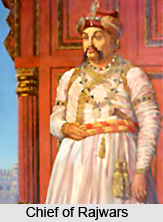 History of Sultanpur District talks about all those facts and events that are associated with its origin. It is seen that the chief land owning families of the past were the Rajputs of the various clans, who possessed the major portion of the total land area. Among them the Rajkumars possessed over one-fourth land of the total area of the district, while their kinsmen, the Bachgotis and Rajwars owned comparatively less percentage of land. The Rajputs with large properties in the district were the Bhale Sultans. Another important branch of the land owning clans was the house of Raj Shah. The chief of the Rajkumars was the Raja of Dera. The head of Bachgotis was the Raja of Kurwar while the taluqdar of Samrathpur represented another branch of the family. The chief of Rajwars was the taluqdar of Pratabpur. Another member of the Rajwars family was the Raja of Hasanpur All these local rajas were under the control of Delhi Sultanate and Nawab of Avadh.
History of Sultanpur District talks about all those facts and events that are associated with its origin. It is seen that the chief land owning families of the past were the Rajputs of the various clans, who possessed the major portion of the total land area. Among them the Rajkumars possessed over one-fourth land of the total area of the district, while their kinsmen, the Bachgotis and Rajwars owned comparatively less percentage of land. The Rajputs with large properties in the district were the Bhale Sultans. Another important branch of the land owning clans was the house of Raj Shah. The chief of the Rajkumars was the Raja of Dera. The head of Bachgotis was the Raja of Kurwar while the taluqdar of Samrathpur represented another branch of the family. The chief of Rajwars was the taluqdar of Pratabpur. Another member of the Rajwars family was the Raja of Hasanpur All these local rajas were under the control of Delhi Sultanate and Nawab of Avadh.
Muhammad Shah, the then Mughal emperor at Delhi, appointed Shri Girdhar Bahadur Nagar as the first Governor of Avadh who was shortly transferred. Saadat Khan (1722-1739) became the first Nawab of Avadh on September 9th, 1722 and was given the title of Burhan-ul-Mulk. In 1739 he was succeeded by his nephew and son-in-law Safdar Jung (1739-1754) who died on October 5th, 1754. His son Shuja-ud-Daulah (1754-1775) succeeded him as the Nawab of Avadh. He fought the famous battle of Buxar along with Shah Alam II, and Mir Qasim, Nawab of Bengal against the British rulers and had to enter into a treaty with them after their defeat. Asaf-ud-Daulah (1775-1797), his son, succeeded Shuja-ud-Daulah on January 31st, 1775.
Further, according to the history of Sultanpur District during the British rule, the condition of the region worsened. Asaf-ud-Daulah died in 1797. Wazir Ali, son of Asaf-ud-Daulah became the Nawab of Avadh but sooner Saadat Ali Khan (1798-1814) became the Nawab in 1798. He died in July, 1814. Ghazi-ud-Din Haidar (1814-1827), son of Saadat Ali Khan, was the next Nawab of Avadh and got the title of `king` by Warren Hastings. He was succeeded by his son Nasir-ud-Din Haidar (1827-1837). The later Nawabs, Muhammad Ali Shah (1837-1842) and Amjad Ali Shah (1842-1847) continued the administration of Avadh who were followed by the last Nawab of Avadh, Wajid Ali Shah (1847-1856) who was deposed by Lord Dalhousie and Avadh became a part of British territory.






